GLIDER PHASE OF D-DAY BEGINS
RAF Aldermaston and Ramsbury Airfields, England • June 3, 1944
On this date in 1944 in Aldermaston, England, men of the 434th Troop Carrier Group and the 101st Airborne Division (“Screaming Eagles”) began moving 52 CG‑4A engineless combat gliders and C‑47 Skytrain tug planes onto the airfield to lead the glider phase of Operation Overlord, the invasion of Nazi-occupied France.
Taking off 5 minutes behind the 434th from Ramsbury airfield over 100 miles/161 km to the west was the 437th Group towing 52 CG‑4A combat gliders for the 82nd Airborne Division (“All Americans”). Each of these flimsy, powerless, unarmed gliders carried 13 men and their gear or 3 men and cargo (equivalent to 1 stick): a Jeep or a Jeep trailer fully loaded with combat supplies, a bulldozer to make landing strips for later glider landings, a 75 mm howitzer or 37 mm antitank gun, or 4,000 lb/1,814 kg of sundry ammunition and/or medical supplies. Gen. Maxwell Taylor, 101st Airborne commander, stretched out on the floor on pillows in his lead C‑47 named Brass Hat, catching shut-eye during the hour-long flight. Glidermen mostly remained seated in their flimsy craft, helmet in lap into which some vomited though most vomit ended up on the floor. Prop wash from the tow plane’s twin engines beat on the glider’s stretched canvas skin, creating the sensation of one being inside a deafening bass drum.
Over Guernsey and Jersey, the German-occupied Channel Islands, enemy flak batteries opened fire on the streams of Skytrains and their trailing gliders en route to the Cotentin Peninsula and their drop zones behind the Allied invasion beaches. Over France, flying at 1,000 ft/305 m (jump altitude) or less, the aerial armada was within crossfire range of German machine guns and flak guns, which pockmarked the black sky with orange tracer rounds and fiery, red explosions. (Seventeen Skytrains were shot down.) Skytrain and glider pilots, nicknamed “suicide jockeys,” weaved and twisted their craft as they took evasive action, throwing nerve-frazzled, heavily burdened men inside the fuselage this way and that, the bruising and bone-jarring made worse by slipping on the vomit-strewn floor.
Twenty-four hours earlier the Germans had begun studding the fields and pastures in the two intended landing zones with “Rommel’s asparagus” (tall interlocking wooden poles) and were digging and flooding 6 ft/1.8 m deep by 10 to 12 ft/3 to 3.7 m wide ditches across other fields to hinder glider landings. U.S. casualties in men and equipment were heavy in the nighttime and early morning (4 a.m.) landings behind Utah Beach, 1 of 2 U.S.-assigned invasion beaches on June 6, 1944. Gliders swooshed in from every direction as pilot after pilot broke formation in an effort to avoid incoming ground fire. Many gliders overshot the fields and plowed into surrounding hedgerow fences, farmhouses, or stone walls, blind in the black night. Some occupants were impaled by the glider’s splintering wood or were crushed when equipment broke away from the plywood floor. One glider landed on a landmine. Some gliders missed their landing zone and crashed into a swamp 12 miles/19.3 km to the south. Twenty-one of the 850 gliders carrying infantrymen were wrecked in landing.
Over 20,000 parachute and glider infantrymen were delivered to Normandy, the overwhelming majority thrown into combat for the first time. Of the roughly 4,000 sky soldiers who participated in the initial airborne assault phase, 10 percent became casualties, either killed or maimed. (More casualties occurred in glider landings than in parachute jumps from transport planes.) But of course Operation Overlord’s success or failure depended on the amphibious landings and the German response.
Waco CG-4A Combat Gliders in the Airborne Invasion of Normandy, 1944
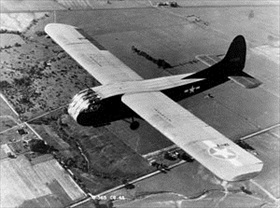 | 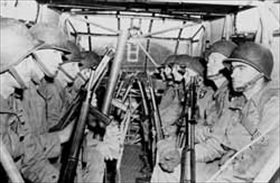 |
Left: Forerunners of today’s helicopter-delivered airmobile troops, these large “flying-boxes-with-wings” came of age in World War II when they were made capable of getting a whole squad or more of infantry, with heavy weapons, onto the ground quickly, with the equipment that paratroopers simply could not carry. The Waco CG‑4A combat glider (C for cargo, G for glider) was the most widely used U.S. troop and cargo military glider of World War II. Derisively called “flak bait” or “flying coffins,” 13,909 of these stealthy combat aircraft were manufactured by 16 companies during the period 1942–1945—more than the number of B‑17, B‑25 or B‑26 bombers; P‑38, P‑39, or P‑40 fighters; or any of the C‑46, C‑47, or C‑54 transport planes manufactured during that same time period.
![]()
Right: At 3,750 lb/1,700 kg the engineless CG-4A (Cargo Glider Model 4A) high-wing monoplane could carry more than its own weight in payload, and frequently did. Its maximum speed was 150 mph/241 km at 7,500 lb/3,402 km or 128 mph/206 km at 9,000 lb/4,082 km. As a troop carrier the combat glider carried 2 crew members (pilots) and 13 infantrymen (“glidermen”) in cramped quarters, many of them burdened by upwards of 200 lb/91 kg of equipment and weapons, such as Browning Automatic Rifles (BARs) and bazookas shown here. Configured as a cargo carrier with 2 crew members, it carried 4 infantrymen and 1 Jeep or 3 infantrymen, 1 75 mm howitzer, and 25 rounds of ammunition. Once on the ground, aircrews took up arms and fought as part of the infantry units they delivered to the target. Some 5,500 gutsy pilots won their glider qualification wings during World War II; 80 percent of them trained at South Plains Army Airfield in Lubbock, Texas. Their wings sported a “G,” which they joked stood for “Guts.” Glider pilots delivered 30,000 troops to combat zones and suffered a 37 percent casualty rate, some of the highest casualty rates of the war. Considering the innumerable acts of courage that took place in Normandy, just 2 members of an airborne or glider unit received the Medal of Honor for extraordinarily heroic actions performed during Operation Overlord.
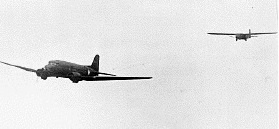 | 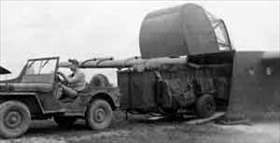 |
Left: Unarmed and unarmored, canvas-covered gliders were towed behind Douglas C‑47 tug planes on 300 ft/91 m by 1 in/2.5 cm nylon ropes. Communication between the early gliders and their tugs was via a telephone wire wrapped around the tow rope, or tow line. These wires often shorted out while being dragged along concrete runways during takeoffs. Two-way radios eventually replaced this system. On approach to the landing zone, the glider’s tow line was released.
![]()
Right: The combat glider had a length of 48 ft 8 in/14.8 m and a wingspan of 83 ft 8 in/25 m. It had a height of 15 ft 4 in/4.6 m. The entire nose section (including the pilot’s compartment) of the CG‑4A swung upward, creating a 70 in/1.8 m by 60 in/1.5 m opening into its cargo compartment. This made it possible to quickly load and, after a successful belly-flop landing, unload the glider.
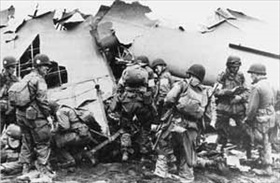 | 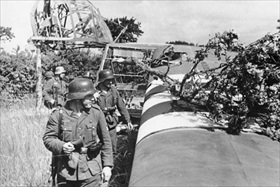 |
Left: A normal 3-point landing required a landing run of 600 ft/183 m to 800 ft/244 m. Combat gliders at the far end of gross weight needed 2,000 ft/610 m to 3,000 ft/914 m. In this photo U.S. troops examine a crashed glider. Built for just 1 flight and a violent end at that, almost every glider used in Normandy was lost. Few undamaged craft were ever retrieved.
![]()
Right: Germans examine the remains of this combat glider that landed in their midst, having crashed into a hedgerow in the inky darkness. (For gliders the hedgerows were too close together and the ground rough.) Several of the occupants in this glider were killed and the rest were overpowered and taken prisoner. The 101st Airborne Division lost 30 men in glider crashes on D‑Day, among them Brig. Gen. Donald F. Pratt, the 101st Airborne’s deputy commander, who died of a broken neck when his CG‑4A Waco glider skidded into a hedgerow (could this photo be of Pratt’s glider?); the 82nd lost 10 times as many.
Airborne Invasion of Normandy, France, June 1944
![]()

 History buffs, there is good news! The Daily Chronicles of World War II is now available as an ebook for $4.99 on Amazon.com. Containing a year’s worth of dated entries from this website, the ebook brings the story of this tumultuous era to life in a compelling, authoritative, and succinct manner. Featuring inventive navigation aids, the ebook enables readers to instantly move forward or backward by month and date to different dated entries. Simple and elegant! Click
History buffs, there is good news! The Daily Chronicles of World War II is now available as an ebook for $4.99 on Amazon.com. Containing a year’s worth of dated entries from this website, the ebook brings the story of this tumultuous era to life in a compelling, authoritative, and succinct manner. Featuring inventive navigation aids, the ebook enables readers to instantly move forward or backward by month and date to different dated entries. Simple and elegant! Click 











